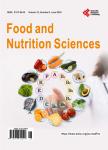Nutritional Screening in a University Hospital:Comparison between Oncologic and Non-Oncologic Patients
营养筛选的大学医院:肿瘤学和非肿瘤学病人比较作者机构:Division of Clinical NutritionDepartment of Internal MedicineSchool of Medicine of Ribeirao PretoUniversity of Sao PauloRibeirao PretoBrazil Parenteral and Enteral Nutrition Team of Clinical HospitalSchool of Medicine of Ribeirao PretoUniversity of Sao PauloRibeirao PretoBrazil Division of OncologyDepartment of Internal MedicineSchool of Medicine of Ribeirao PretoUniversity of Sao PauloRibeirao PretoBrazil
出 版 物:《Food and Nutrition Sciences》 (食品与营养科学(英文))
年 卷 期:2015年第6卷第1期
页 面:75-82页
学科分类:1002[医学-临床医学] 100214[医学-肿瘤学] 10[医学]
主 题:Nutritional Screening Malnutrition Subjective Global Assessment Hospital Setting Neoplasia
摘 要:Background & Aims: We compared the screening nutritional data of patients with malignant and non-malignant disease, and classified their nutritional risk according to the primary tumor’s site. Methods: Subjective Global Assessment was applied to 3008 patients within 48 h of admission to a public university. Subjects were divided into Oncologic Group (n = 576) or Non-Oncologic Group (n = 2432) according to the presence of neoplasms or other diseases respectively. These data were compared by the t-student test and classic chi-square test, with statistical significance set at p 0.05. Results: The Oncologic Group presented a higher prevalence of weight loss (60.3% vs. 49.3%), quantitative (40.7% vs. 28.5%) and qualitative (16.4% vs. 7.6%) alterations in the food intake pattern, gastrointestinal symptoms and muscle waste (23.2% vs. 13.2%) as compared to the Non-Oncologic Group. Also, there was a higher prevalence of nutritional disturbances in the Oncologic Group, with 49.5% of the subjects moderately (or suspected to be malnourished) and 12.7% severely mal-nourished. Severe malnourishment was mainly observed in patients with head and neck (25%), upper digestive tract (21.9%) and soft tissue and bones (17.9%) tumors. Conclusion: When compared to other hospitalized patients, patients with neoplastic disease were in higher nutritional risk.



